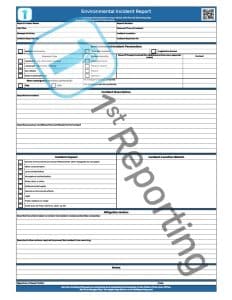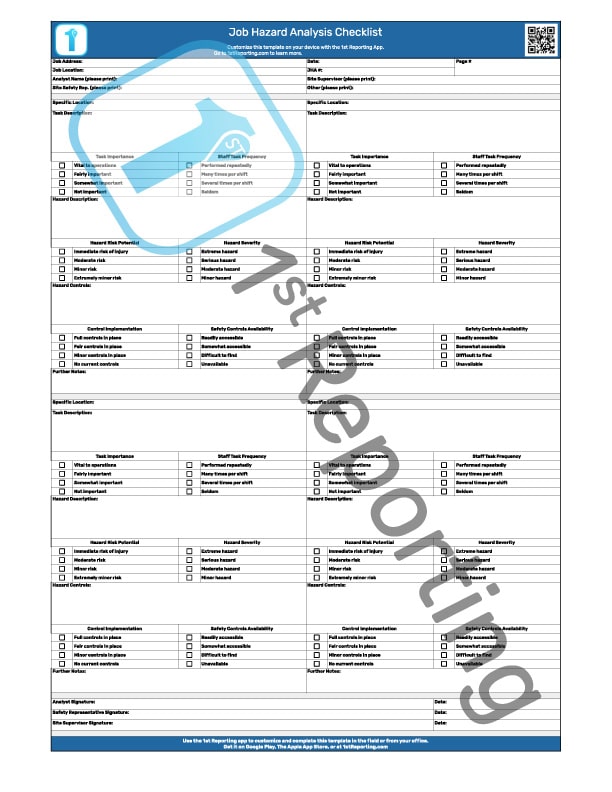The Environmental Incident Report Template is the tool you need for documenting Environmental incidents. These incidents are tragic – but they occur, and when they do, you need to have the tools to deal with them. Spill kits and physical means of cleaning up after environmental incidents are vital, but so is documenting the incident. That’s where our Environmental Incident Report Template becomes a critical part of your ecological incident mitigation process.
An Environmental Incident Report includes all the essential information needed to appropriately document an environmental incident and the steps taken to mitigate it.
This article will discuss what’s included in and the best use of the Environmental Incident Report for business. We will also deliver some great actionable tips to help you manage the environmental incident reporting process more effectively and maybe even allow you to eliminate further occurrences. Let’s dive in.
Included In The Environmental Incident Report
The Environmental Incident Report template we have created consists of seven sections:
- Administrative
- Environmental Incident Parameters
- Incident Description
- Incident Impact
- Incident Location Sketch
- Mitigation Action
- Notes & Sign Off
Here’s a brief description of the elements included in each of these seven sections. Understanding each will enable your team to better complete the form when it arises, so it’s best not to skip over this section.
Administrative
As with any standard incident report, the administrative section includes information such as the name and title of the report creator, the manager on duty, and information about who reported the incident and to whom. Similarly, the report includes a place to note a report number (for tracking and filing purposes) and the incident’s date, time, and location. As you can see, it is vital, if a not critical section of the report, not to overlook it.
Environmental Incident Parameters
There are many parameters of an incident that require definition to understand the nature of the event in its entirety. The first is a three-choice selection to classify the overall incident as an occurrence, near miss or legislative breach.
The following parameter is the exposure type, and besides that, the incident assumed severity.
Another critical element of documenting any environmental incident is to include the names of those affected and the names and contacts of emergency services contacted. This information would be vital for follow-up purposes after the fact, so it is indispensable to record it in the initial report.
Incident Description
A full description of the incident and the conditions that led up to the incident are necessary for appropriate analysis and further actions taken. Similarly, mitigation will require in-depth knowledge of those conditions that led to the incident. This section is dedicated to recording such information, and ample space is provided for the report writer to complete the documentation of the critical incident description.
Incident Impact
Understanding how an environmental incident will impact an organization is critical. This section reveals several common impacts that environmental incidents may trigger. The report creator must select all those that apply to the incident.
Incident Location Sketch
A brief sketch of the location and incident may reveal truths not yet communicated in words. They say a picture speaks a thousand words, so it is essential to convey further information. The report writer may use this space to sketch the area where the incident occurred.
Mitigation Action
Containing and preventing further environmental damage is the only logical solution to an ecological incident. The mitigation action section of the Environmental Incident Report completes the cycle by allowing the report creator to note the actions taken to stop the spread of contaminants or other environmentally damaging situations. Similarly, there is also an area where one may record further steps required to sustain a preventable response to environmental incidents.
Notes & Sign Off
At the end of the report template, you will find an area for brief notes and a sign-off area for the report writer to validate the report’s authenticity.
How To Use The Environmental Incident Report Template

Using the Environmental Incident Report Template is easy – just download, print, and hand it out to your team. Although, we do recommend you manage your environmental reporting by creating an Environmental Management Procedure.
If you’re looking for some tips that will help you manage environmental incident scenarios, read our post Environmental Incidents In The Workplace – A Manager’s Guide. We’ve included loads of vital information you need to know, so don’t miss reading it.
7 Tips For Managing and Reporting Environmental Incidents

Armed with the proper knowledge and a few handy tips, you can be prepared to handle any environmental incident. Here are seven of our top recommendations for how you can manage the situation when it arises:
- Create an Environmental Management Procedure (EMP) that covers all bases of your organization’s actions in response to different incidents. It will help ensure consistency across departments and provide guidance on how to react during emergencies.
- Make sure that everyone involved is aware of their specific role in case something happens, so they know where they need to start looking if there isn’t time before the emergency call comes through or someone else gets injured. Your EMP should include information about who needs to contact whom, who’s designated as first responders, and more.
- Be proactive about environmental incidents and don’t wait for them to happen before taking steps to mitigate potential damage – this includes conducting drills and training employees on what to do if an incident does occur.
- Keep accurate records of all environmental incidents, including what happened, the steps taken to mitigate them, and any follow-up actions that were required. This documentation will be vital for follow-up purposes after the fact, so it is indispensable to record it in the initial report.
- Ensure you have a designated contact person who a team member can reach 24/7 in an emergency. This individual should have access to all necessary resources, such as spill kits and personal protective equipment, to deal with any incident.
- When it comes to environmental incidents, time is of the essence. The faster you can get on top of the situation, the more minor damage will be done. Use the 1st Reporting app to create and submit your environmental incident report quickly and easily from any mobile device.
The Future Of Environmental Incident Documentation
Apps like 1st Reporting are changing the future of environmental reporting by making it easier than ever for businesses to document and manage incidents as they happen.
The app provides vital information for follow-up purposes, but it also allows businesses to track their environmental performance over time. In addition, apps like 1st Reporting offer features like GPS tracking and photo/video documentation that make it easier to gather accurate information in the field.
So, what does this mean for the future of environmental incident reporting?
It means that businesses no longer have to wait until an incident is over to start documenting it. With mobile form automation solutions like 1st Reporting, companies can quickly and easily submit reports from any location, ensuring that all the necessary information is captured accurately and rapidly. It makes life easier for business owners and managers and helps to improve safety and compliance by providing a central repository for all environmental incident data.
When it comes to environmental incidents, being prepared is vital. Make sure you download and use the Environmental Incident Report Template to ensure that you have everything you need to document an incident effectively. And don’t forget to download the 1st Reporting app to make reporting even easier!
Try a demo of 1st today and see how easy digitally reporting incidents can be!





